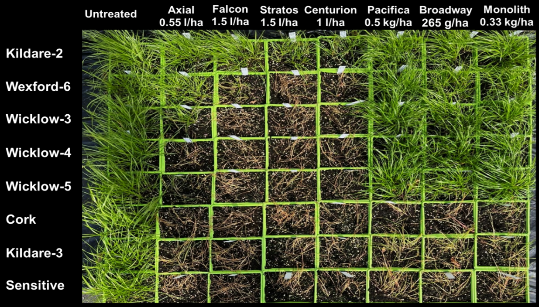Monitoring by Dr Vijaya Bhaskar at Teagasc Oak Park in Ireland has found a complex resistance picture in mixed grass weed populations that helps inform herbicide choice.
Understanding the Spread of Herbicide Resistance with Dr. Vijaya Bhaskar
Since 2019, Dr. Vijaya Bhaskar has been at the forefront of monitoring herbicide resistance in Ireland through the Teagasc Weed Watch initiative. Farmers send samples from fields where herbicide performance is lackluster, aiming to identify and understand resistance patterns.
A detailed look at the study
Dr. Bhaskar's research focuses on popular contact-acting herbicides, particularly those based on ACCase (clethodim, cycloxydim, pinoxaden, propaquizafop) and ALS chemistry (mesosulfuron, iodosulfuron, pyroxsulam). Initially, the study targeted sterile brome and wild oats. However, as blackgrass and Italian ryegrass began spreading, these weeds also became significant points of concern.
Dr. Bhaskar notes the complexity of the situation: "For blackgrass and Italian ryegrass, we see new fields every year. The spread is quite complex due to both native weeds and suspected introduced species. Rats tail fescue is also becoming an issue in min-till situations."
Complex resistance patterns uncovered
The findings reveal a nuanced resistance pattern among weed populations, especially where mixed grass weed populations exist. Resistance in Irish strains appears to have evolved, driven by the weeds' natural tendency to adapt to herbicide actives. Dr. Bhaskar explains that while herbicides like clethodim and cycloxydim rarely develop non-target site resistance, resistance through target site mutations is common.
"Clethodim is less affected by target-site resistance due to the specifics of mutations, zygosity, and the ploidy level of the grass-weed," Dr. Bhaskar elaborates.
The 2023 results align with previous findings, showing that Centurion Max (clethodim) effectively controls blackgrass samples, whereas 42% of these samples were cross-resistant to other tested herbicides. Italian ryegrass presented a more challenging picture, with 15 out of 17 samples showing resistance to ALS or ACCase chemistry, except for Centurion Max, which remained effective in most cases.
Expert insights on herbicide performance
Antonia Walker, a technical specialist at UPL, underscores the significance of these findings. She attributes Centurion Max's superior performance compared to other ACCase herbicides to clethodim's reduced sensitivity to the 1781 mutation, which significantly impacts other herbicides in the group. "The main mutation affecting clethodim is 2078," Antonia explains. "This mutation is less common in UK blackgrass populations but more frequent in Italian ryegrass. Despite this, clethodim retains some effectiveness."
UPL continues to monitor resistance levels in grass weeds and advises farmers to engage in programs like Teagasc Weed Watch. Participating in such initiatives and testing grass weed seed samples can provide valuable data for managing resistance.
Tips for Optimising Grass Weed Control in Oilseed Rape
Antonia Walker offers advice for farmers aiming to control grass weeds in oilseed rape effectively. UPL's research indicates that a mid-October application of Centurion Max, followed by a mid-December application of propyzamide, yields the best results. Delaying propyzamide until mid-January reduces its effectiveness by nearly 10%.
Farmers can further enhance Centurion Max's performance by following a few key steps:
- Timing: Apply Centurion Max before October 15 or when the crop is within six true leaves to ensure crop safety and herbicide effectiveness.
- Water Conditioners: Research shows that using water conditioners can increase blackgrass control by 11% on average, especially in resistant populations.
- Application Windows: Maintain a ten-day interval between applying any pesticide and Centurion Max, and avoid applying any other pesticide for fourteen days after using Centurion Max.
By adhering to these guidelines, farmers can improve their grass weed management strategies and adapt to the evolving resistance landscape.
